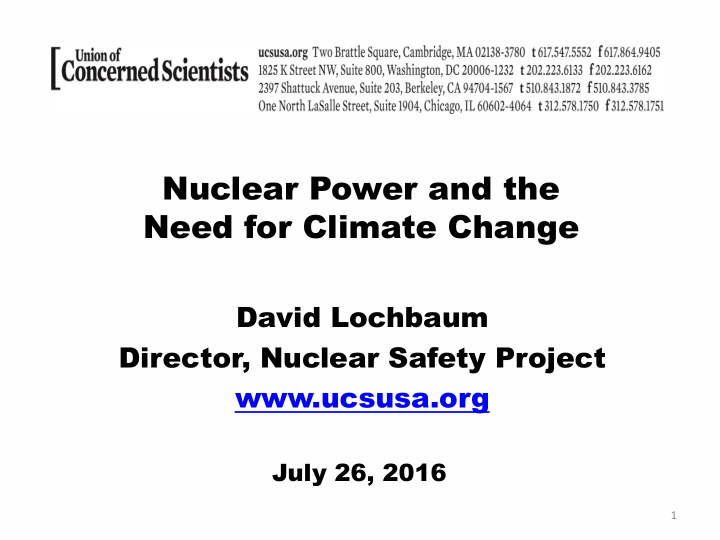



Nuclear Power and the Need for Climate Change David Lochbaum Director, Nuclear Safety Project www.ucsusa.org July 26, 2016 1
Topics NRC’s Safety Culture Goal vs. Reality NRC’s Safety Conscious Work Environment Goal vs. Reality Climate is Changing in the Wrong Direction Need for Changing this Climate 2
Safety Culture Goal “The NRC defines nuclear safety culture as the core values and behaviors resulting from a collective commitment by leaders and individuals to emphasize safety over competing goals to ensure protection of people and the environment.” Source: NRC Safety Culture Policy Statement 3
Safety Culture As-is “Compared to 2009, NRC has significantly decreased in eight categories, including Differing Views processes, Engagement, Empowerment and Respect, … , NRC Mission & Strategic Plan, … Elevating Concerns …” Source: 2015 NRC Safety Culture and Climate Survey (ML16106A012) 4
Safety Culture As-is “Quality Focus: … a larger portion of participants feel that great pressure is put on meeting metrics rather than on producing quality work” Source: 2015 NRC Safety Culture and Climate Survey (ML16106A012) 5
Safety Culture As-is “Open Collaborative Work Environment: Although participants think NRC has a collective mind-set for a collaborative work environment, many do not think this mind-set actually translates into collaborate working conditions. Participants feel that values such as openness and collaboration are no longer practiced.” Source: 2015 NRC Safety Culture and Climate Survey (ML16106A012) 6
Safety Conscious Work Environment Goal “A safety conscious work environment is maintained where personnel feel free to raise safety concerns without fear of retaliation, intimidation, harassment or discrimination.” Source: NRC Safety Culture Policy Statement 7
Safety Conscious Work Environment As-is “Elevating Concerns and Empowerment: ... Other employees feel that although there is a strong encouragement to elevate concerns, it is stigmatizing to actually do so.” Source: 2015 NRC Safety Culture and Climate Survey (ML16106A012) 8
Safety Conscious Work Environment As-is “Differing Views Processes: … A majority of participants feel the non-concurrence program was put in place only to document disagreements and are concerned that if you disagree with your manager it can, and most likely will, affect your career path and advancement.” Source: 2015 NRC Safety Culture and Climate Survey (ML16106A012) 9
Safety Conscious Work Environment As-is “… many of the [non -concurrence program] submitters believed they experienced some type of negative consequence as a result of submitting a non-concurrence. Source: 2014 Non-Concurrence Process Assessment (ML14056A294) 10
Safety Conscious Work Environment As-is “75 percent believed that their performance evaluations were adversely affected, 63 percent felt they were excluded from work activities, and 25 percent thought they were passed over for career development.” Source: 2014 Non-Concurrence Process Assessment (ML14056A294) 11
Safety Conscious Work Environment As-is 6% of 209 workers exiting the NRC said that dissatisfaction with inaction by the agency was a factor in their decision to leave 4% of the 209 workers exiting the NRC said that fear of reprisal for raising a differing view was a factor in their decision to leave Source: NRC Exit Survey (April 2015 – March 2016) (ML16109A345) 12
Climate Change in Wrong Direction “Differing View Processes: Assesses employee awareness and perceived effectiveness of the Differing Professional Opinions and the Non- concurrence process.” 2015: 47% Total Favorable Score 2012: 50% Total Favorable Score Source: 2015 NRC Safety Culture and Climate Survey (ML16106A012) 13
Climate Change in Wrong Direction “Quality Focus: Evaluates employees’ perception of NRC safety culture, how safe they feel at work, and NRC’s commitment to public safety.” 2015: 51% Total Favorable Score 2012: 54% Total Favorable Score Source: 2015 NRC Safety Culture and Climate Survey (ML16106A012) 14
Perception Gap Overall SES* Differing Views 47 81 Quality Focus 51 77 Elevating Concerns 60 89 * It’s hard to solve problems you don’t see. Source: 2015 NRC Safety Culture and Climate Survey (ML16106A012) 15
Need for Climate Change “I can disclose a suspected violation of any law, rule or regulation without fear of reprisal” 2015: 74.8% 2010: 80.2%” Source: 2016 Federal Employee Viewpoint Survey Report (ML16102A305) 16
Need for Climate Change “I am frequently worried about the following impacting the future of the NRC: Nuclear Events 13% Project AIM 50%” Source: 2015 NRC Safety Culture and Climate Survey (ML16106A012) 17
Need for Climate Change “I believe the results of this survey will be used to make my agency a better place to work” 2015: 56.4% 2010: 72.2%” Source: 2016 Federal Employee Viewpoint Survey Report (ML16102A305) 18
Need for Climate Change “I believe the results of this survey will be used to make my agency a better place to work” Please prove 2015: 56.4% them wrong! 2010: 72.2%” Source: 2016 Federal Employee Viewpoint Survey Report (ML16102A305) 19
Recommend
More recommend